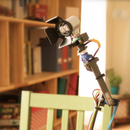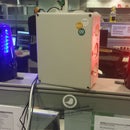Introduction: How to Revive an Old Radio: the Easy Honest Cheat!
A couple of weeks ago, I've been with my wife to a "vide-greniers" (garage sale) next door in Paris. In the midst of jumble of people and their stuff laying all around, I found an old tube radio sitting on the side walk, it is in excellent condition, at least judging by the looks, the guy is offering it for 15 euros!! "Does it work?" I ask, the old french guy responds: " Yes, when I last checked in the 80s".
The radio is an ISIS 628, built in 1946, I asked if we can try it, he suggested that we can do so in the restaurant at the corner. But to my disappointment, after giving it some power, there was no pulse, although I've waited a while for tubes to warm up, but still no sign of life.
Nevertheless, I can't leave this treasure behind, especially that my wife has already fallen in love with it, so I took it, for even a more reduced price, a 10 euros, with the guy apologizing that it doesn't work (what a sweet world!)
I was all hopes that at home, I will power it up for half an hour and go back in time 67 years! but instead, all what I get is electrostatic and very load hum.
I have no experience in fixing radios, I don't know where to start beyond changing tubes and filter capacitors, which will cost a lot(relative to start price), not to mention that getting it fixed by a professional will cost even more and most importantly will ruin the fun of doing it yourself... so I made a very hard decision that I am still recovering from: remove all old electronics, and put a new radio inside, but while keeping the old interface authentic as is.
...and it worked :) As I am writing this Instructable, I am listing on it to Miles Davis on NRJ Paris FM! Yes, a vintage radio from 40's with FM!
I am happy to share with you what I did to revive this radio, I hope you will find it useful. Please note that the steps can't be generic, as details need to be modified according to the type of radios you are swapping.
Here is a video of the radio after reviving it:
Good luck, and sorry if the below images will cause any discomfort for vintage-radio enthusiasts, I am really sorry, I totally understand.
:)
Material needed:
After you've got your old radio, you need:
- A small kitchen radio, any would do it given that it has analog knobs (don't get digital radios that have buttons), I got mine for 17 euros. it is an AM/FM radio.
- 2 tubes of instant-glue
- 2m of electric wires
- A set of screws (you can reuse the ones coming out from the old and new radio)
- 4 ring screws
- A 1m silk wire or of other material (will be used in the pulley system to move the station indicator needle)
- Some pieces of wood (I used layers of Balsa wood as it is very easy to work with using a cutter)
Here is on top the new kitchen radio I picked up:
1. Remove old electronics from old radio
WORD OF CAUTION: old radios can have big capacitors that can store up to 400 V, touching one or floating wires in the wrong place can KILL, so please pay great attention when removing the old electronics chassis, also please always disconnect power when working.
After unscrewing and some serious muscle work, I managed to get the radio electronics out (that was an emotional moment :( ), which leaves me with nothing but a beautiful wooden box, but I also kept the old 8-inch speaker, it has a great sound. Make sure to save the knobs and all pulleys and screws you get out, we will definitely need many of them.
2. Remove the new radio's electronics board
That's easy!
3. Interface the old radio's knobs with the new radio's electronic board
In my case, I stick to the basics, a volume knob and the station needle knob need to work as they used to be in the old radio. I didn't interface other knobs (the wave and EQ selector knobs), but I put those as a dummy knobs to preserve the old looks of the radio.
The volume knob:
Desolder the volume pot (variable resistor) from the new radio board, and reconnect it using wires, this to have flexibility in putting the volume knob at distance from the electronic board. Another option would be to use a multi-meter to measure the resistance of the pot (mine was 47Kohm) and get a similar one then connect it through wires and directly solder them to the board, but you still have to remove the old volume pot.
I built a small wooden support structure to hold the pot,the pot shaft and knob, a lot of eye-balling and trial and errors were involved, but here what i got:
The station needle and knob
This part was very tricky, because the new radio has very small dimensions compared to the old one, and you need to have same knob moving the station needle and also turning the station selector pot to its full range to have all stations tune-able.
Using the needle, pulley and knob from old radio, I built another support structure to connect them all together.
To move the needle from one end to another, I used the big pulley from the old radio, I connect it directly to the shaft of the knob to get maximum torque and amplification of needle movement. I used the silk wire along with a couple of ring screws to make the pulley system that moves the needle. I first fix the big pulley then moved the needle to far left to right, then I wined the silk wire around them to the exact measure. I fix the wire from both ends and cut the extra part. Now when I turn the knob, the needle moves from far left to far right. how cool is that :) Again, a lot of eye-balling and trial and errors were involved, but i finally got it working.
Another challenge was to connect the knob and its pulley to the station-tuning pot on the board. Since the new radio I have uses 2-stage pulley system with 4:1 ratio, to allow fine tuning of stations with minor effort, thus a lot of turning is needed on the smaller secondary knob (right one) to have some movement on the bigger internal knob (center one, which is connected to the tuning pot below it on the board).
This means you will need to turn the small knob 4 times (360 degrees x 4) to have the bigger knob turning full range (90 degrees). To solve this easily, I removed the small knob, and I connected the old radio knob and shaft directly to the bigger knob/pot on the board, this means, the ratio is now 1:1, 90 degrees turn on the knob will also move the tuning pot 90 degrees, that is, its full range.
Voila, I turn the tuning knob all the way, I can select any station, and have the needle moving synchronously from far left to far right.
4. Putting all together
I finally fixed the board as shown in the picture, added dummy knobs to the front panel, connected the speaker wires from the board to the old speaker, fixed in place the small transformer, power socket and antenna, and I am done.
An FM/MW/LW/SW vintage radio that is light weight, and that can be also portable by using batteries.
I turned it on, picked an FM channel, smiled, and went directly to write this Instructable :)
Hope you like it, please let me know if you have any comments or suggestions. I will be soon be adding a light for the front panel and extend the on/off button to be easily accessible from the outside, and finally adding a tube amplifier to restore some of the vintage sound imperfections.
The radio is an ISIS 628, built in 1946, I asked if we can try it, he suggested that we can do so in the restaurant at the corner. But to my disappointment, after giving it some power, there was no pulse, although I've waited a while for tubes to warm up, but still no sign of life.
Nevertheless, I can't leave this treasure behind, especially that my wife has already fallen in love with it, so I took it, for even a more reduced price, a 10 euros, with the guy apologizing that it doesn't work (what a sweet world!)
I was all hopes that at home, I will power it up for half an hour and go back in time 67 years! but instead, all what I get is electrostatic and very load hum.
I have no experience in fixing radios, I don't know where to start beyond changing tubes and filter capacitors, which will cost a lot(relative to start price), not to mention that getting it fixed by a professional will cost even more and most importantly will ruin the fun of doing it yourself... so I made a very hard decision that I am still recovering from: remove all old electronics, and put a new radio inside, but while keeping the old interface authentic as is.
...and it worked :) As I am writing this Instructable, I am listing on it to Miles Davis on NRJ Paris FM! Yes, a vintage radio from 40's with FM!
I am happy to share with you what I did to revive this radio, I hope you will find it useful. Please note that the steps can't be generic, as details need to be modified according to the type of radios you are swapping.
Here is a video of the radio after reviving it:
Good luck, and sorry if the below images will cause any discomfort for vintage-radio enthusiasts, I am really sorry, I totally understand.
:)
Material needed:
After you've got your old radio, you need:
- A small kitchen radio, any would do it given that it has analog knobs (don't get digital radios that have buttons), I got mine for 17 euros. it is an AM/FM radio.
- 2 tubes of instant-glue
- 2m of electric wires
- A set of screws (you can reuse the ones coming out from the old and new radio)
- 4 ring screws
- A 1m silk wire or of other material (will be used in the pulley system to move the station indicator needle)
- Some pieces of wood (I used layers of Balsa wood as it is very easy to work with using a cutter)
Here is on top the new kitchen radio I picked up:
1. Remove old electronics from old radio
WORD OF CAUTION: old radios can have big capacitors that can store up to 400 V, touching one or floating wires in the wrong place can KILL, so please pay great attention when removing the old electronics chassis, also please always disconnect power when working.
After unscrewing and some serious muscle work, I managed to get the radio electronics out (that was an emotional moment :( ), which leaves me with nothing but a beautiful wooden box, but I also kept the old 8-inch speaker, it has a great sound. Make sure to save the knobs and all pulleys and screws you get out, we will definitely need many of them.
2. Remove the new radio's electronics board
That's easy!
3. Interface the old radio's knobs with the new radio's electronic board
In my case, I stick to the basics, a volume knob and the station needle knob need to work as they used to be in the old radio. I didn't interface other knobs (the wave and EQ selector knobs), but I put those as a dummy knobs to preserve the old looks of the radio.
The volume knob:
Desolder the volume pot (variable resistor) from the new radio board, and reconnect it using wires, this to have flexibility in putting the volume knob at distance from the electronic board. Another option would be to use a multi-meter to measure the resistance of the pot (mine was 47Kohm) and get a similar one then connect it through wires and directly solder them to the board, but you still have to remove the old volume pot.
I built a small wooden support structure to hold the pot,the pot shaft and knob, a lot of eye-balling and trial and errors were involved, but here what i got:
The station needle and knob
This part was very tricky, because the new radio has very small dimensions compared to the old one, and you need to have same knob moving the station needle and also turning the station selector pot to its full range to have all stations tune-able.
Using the needle, pulley and knob from old radio, I built another support structure to connect them all together.
To move the needle from one end to another, I used the big pulley from the old radio, I connect it directly to the shaft of the knob to get maximum torque and amplification of needle movement. I used the silk wire along with a couple of ring screws to make the pulley system that moves the needle. I first fix the big pulley then moved the needle to far left to right, then I wined the silk wire around them to the exact measure. I fix the wire from both ends and cut the extra part. Now when I turn the knob, the needle moves from far left to far right. how cool is that :) Again, a lot of eye-balling and trial and errors were involved, but i finally got it working.
Another challenge was to connect the knob and its pulley to the station-tuning pot on the board. Since the new radio I have uses 2-stage pulley system with 4:1 ratio, to allow fine tuning of stations with minor effort, thus a lot of turning is needed on the smaller secondary knob (right one) to have some movement on the bigger internal knob (center one, which is connected to the tuning pot below it on the board).
This means you will need to turn the small knob 4 times (360 degrees x 4) to have the bigger knob turning full range (90 degrees). To solve this easily, I removed the small knob, and I connected the old radio knob and shaft directly to the bigger knob/pot on the board, this means, the ratio is now 1:1, 90 degrees turn on the knob will also move the tuning pot 90 degrees, that is, its full range.
Voila, I turn the tuning knob all the way, I can select any station, and have the needle moving synchronously from far left to far right.
4. Putting all together
I finally fixed the board as shown in the picture, added dummy knobs to the front panel, connected the speaker wires from the board to the old speaker, fixed in place the small transformer, power socket and antenna, and I am done.
An FM/MW/LW/SW vintage radio that is light weight, and that can be also portable by using batteries.
I turned it on, picked an FM channel, smiled, and went directly to write this Instructable :)
Hope you like it, please let me know if you have any comments or suggestions. I will be soon be adding a light for the front panel and extend the on/off button to be easily accessible from the outside, and finally adding a tube amplifier to restore some of the vintage sound imperfections.




